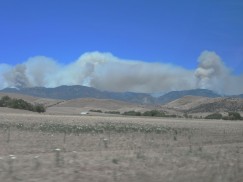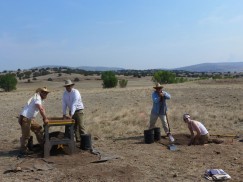- Home
- >
- Preservation Archaeology Blog
- >
- Student Post: First Days at Mule Creek
 |
By Deborah L. Huntley, Preservation Archaeologist
|

Our first student blog post comes from Tom Sprynczynatyk:
As we drove up to the field school camp, I couldn’t help but feel some trepidation. Leaving Safford, about 50 miles southwest from Mule Creek, I could see smoke from the Whitewater-Baldy Fire on the horizon. As we drew closer, the smoke cloud grew until it appeared to tower above us. The staff reassured us that it was still 20 miles off and the prevailing winds made it extremely unlikely it would move any closer, but it’s still surreal seeing the fires glowing on the ridgeline every night.

We received bad news the evening before our first digging day: the winds had shifted and the fire report predicted the smoke would be blown straight at us. The next morning dawned with a blood red sun, the mountains around us obscured by smoke. It hadn’t yet descended to our altitude, so we packed up and headed off to the site to accomplish as much as we could before the smoke arrived.
The excavation started with laying out a unit, creating a precise 2 x 1 meter rectangle with mason’s twine. We were on top of a large depression that was suspected to contain a ceremonial structure called a kiva. We wanted to find the wall of the buried building, which could give us a great deal of information about its construction and purpose.

We collected the few surface artifacts, and then started digging in the dirt. As we troweled down, we soon found what is known as cultural fill—basically, an ancient trash heap. Even though I was sifting through the 800-year-old remains of someone’s lunch, I was elated. I was having the time of my life trying to piece together how each artifact got there and imagining what the life of the person who had left it was like.
Unfortunately, our first field day had to be cut short. The smoke gradually moved down the mountains and became so thick that our eyes turned red and some of us started coughing. As we packed up our gear to head back to camp, the landscape looked like something out of a post-apocalyptic movie. The mountains had totally become obscured by the smoke, the sun was angry red, and ash started falling on us like light snow.
Despite having red eyes, sore lungs, and being covered in dirt, I couldn’t wait to get back to the site. I had been able to do the two things I love best—digging in the dirt and looking for interesting stuff. Having pulled my first artifact out of the ground, I finally felt like a real archaeologist!

Explore the News
-
Join Today
Keep up with the latest discoveries in southwestern archaeology. Join today, and receive Archaeology Southwest Magazine, among other member benefits.